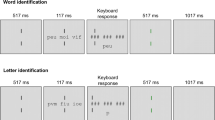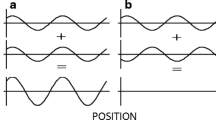Summary
The effects of masking and simultaneous vs sequential exposure on identification accuracy of parafoveally presented pairs of stimuli were examined in four experiments. When masking figures were continuously present in positions not occupied by stimulus characters, accuracy of identification was significantly poorer on the relatively central member of a pair when members were simultaneously exposed and when the central member was exposed second. When masking figures were not used, performance was significantly poorer on the central member only when pair members were exposed simultaneously. Requiring the identification of both members of the pair produced a different ordering of overall accuracy among the simultaneous and sequential conditions from when only one member was identified. It was concluded that asymmetric lateral inhibition of feature extraction operated only when target and nontarget were simultaneously present. An additional source of asymmetric disruption occurs when masking figures flanking the target change before or with the appearance of the target.
Similar content being viewed by others
References
Banks WP, Bachrach KM, Larson DW (1977) The asymmetry of lateral interference in visual letter identification. Percept Psychophys 22:232–240
Banks WP, Larson D, Prinzmetal W (1979) Asymmetry of visual interference. Percept Psychophys 25:447–456
Chastain G (1981) Asymmetric identification of parafoveal stimulus pairs: Feature perturbations or failure in feature extraction? Can J Psychol 35:13–23
Chastain G, Lawson L (1979) Identification asymmetry of parafoveal stimulus pairs. Percept Psychophys 26:363–368
Estes WK (1972) Interactions of signal and background variables in visual processing. Percept Psychophys 12:278–286
Estes WK (1974) Redundancy of noise elements and signals in visual detection of letters. Percept Psychophys 16:53–60
Estes WK, Allmeyer DH, Reder SM (1976) Serial position functions for letter identification at brief and extended exposure durations. Percept Psychophys 19:1–15
Krumhansl CL (1977) Naming and locating simultaneously and sequentially presented letters. Percept Psychophys 22:293–302
Krumhansl CL, Thomas EAC (1977) Effect of level of confusability on reporting letters from briefly presented visual arrays. Percept Psychophys 21:269–279
Taylor SG, Brown DR (1972) Lateral visual masking: Supraretinal effects when viewing linear arrays with unlimited viewing time. Percept Psychophys 12:97–99
Townsend JT, Taylor SG, Brown DR (1971) Lateral masking for letters with unlimited viewing time. Percept Psychophys 10:375–378
White MJ (1976) Order of processing in visual perception. Can J Psychol 30:140–156
White MJ (1981) Feature-specific border effects in the discrimination of letter-like forms. Percept Psychophys 29:156–162
Author information
Authors and Affiliations
Rights and permissions
About this article
Cite this article
Chastain, G. Masking and the identification of characters presented simultaneously and sequentially to the parafovea. Psychol. Res 44, 135–145 (1982). https://doi.org/10.1007/BF00308446
Received:
Issue Date:
DOI: https://doi.org/10.1007/BF00308446




